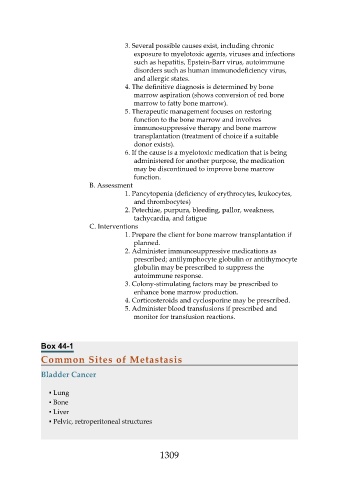Page 1309 - Saunders Comprehensive Review For NCLEX-RN
P. 1309
3. Several possible causes exist, including chronic
exposure to myelotoxic agents, viruses and infections
such as hepatitis, Epstein-Barr virus, autoimmune
disorders such as human immunodeficiency virus,
and allergic states.
4. The definitive diagnosis is determined by bone
marrow aspiration (shows conversion of red bone
marrow to fatty bone marrow).
5. Therapeutic management focuses on restoring
function to the bone marrow and involves
immunosuppressive therapy and bone marrow
transplantation (treatment of choice if a suitable
donor exists).
6. If the cause is a myelotoxic medication that is being
administered for another purpose, the medication
may be discontinued to improve bone marrow
function.
B. Assessment
1. Pancytopenia (deficiency of erythrocytes, leukocytes,
and thrombocytes)
2. Petechiae, purpura, bleeding, pallor, weakness,
tachycardia, and fatigue
C. Interventions
1. Prepare the client for bone marrow transplantation if
planned.
2. Administer immunosuppressive medications as
prescribed; antilymphocyte globulin or antithymocyte
globulin may be prescribed to suppress the
autoimmune response.
3. Colony-stimulating factors may be prescribed to
enhance bone marrow production.
4. Corticosteroids and cyclosporine may be prescribed.
5. Administer blood transfusions if prescribed and
monitor for transfusion reactions.
Box 44-1
Common Sites of Metastasis
Bladder Cancer
▪ Lung
▪ Bone
▪ Liver
▪ Pelvic, retroperitoneal structures
1309

